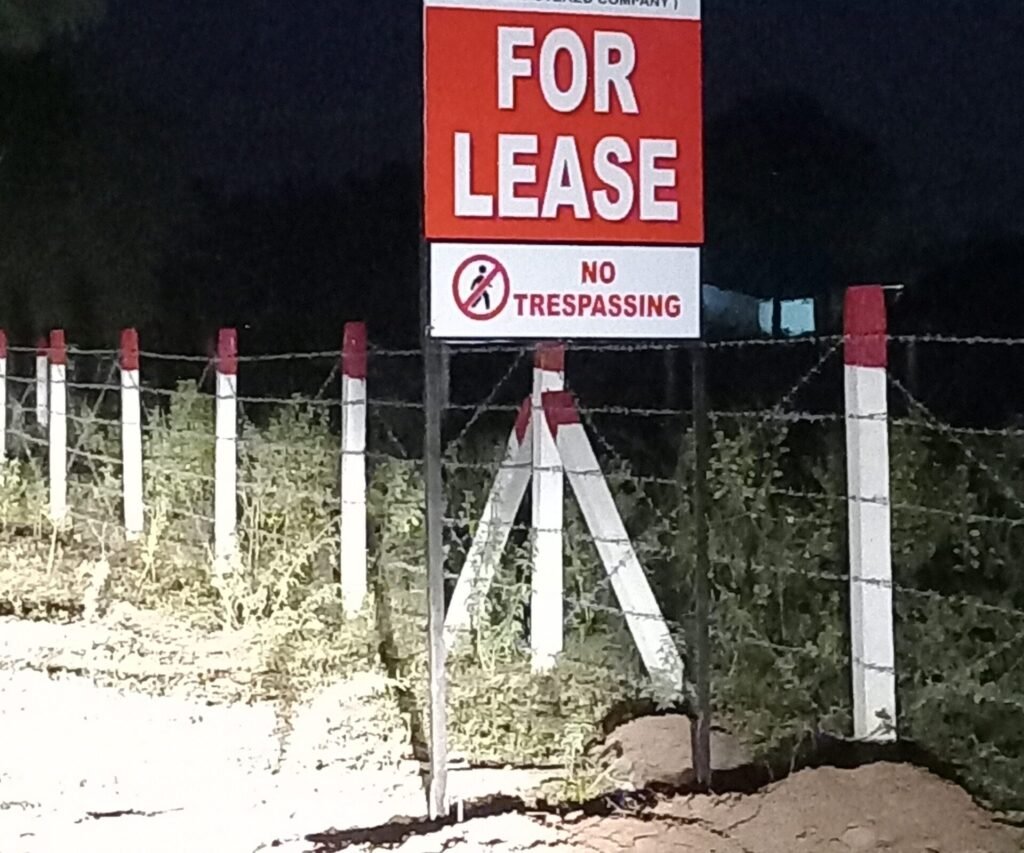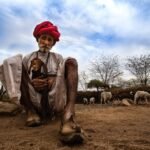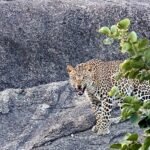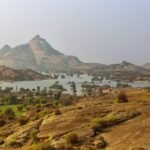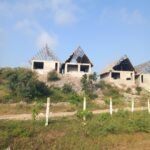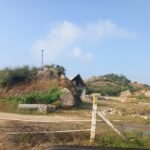Take a look at these pictures. These are all recent images of the ancient landscape of Bera in Rajasthan, where 850-million-year-old granite outcrops pierce the sky, as part of an extraordinary tale of coexistence that has played out for centuries. Here, the Rabari people – traditional pastoralists who believe they were created from Lord Shiva’s sweat and skin to tend his sacred camels – share their land with one of India’s densest leopard populations. This isn’t just coexistence; it’s a sophisticated understanding between human and predator that has evolved over countless generations.
The Rabari’s approach is pragmatic: they accept that leopards will take some of their livestock, typically the weak or elderly animals, viewing it as nature’s way of maintaining a healthy herd. In this rugged terrain, which also harbours hyenas, sloth bears, blue bulls and more than 115 bird species, humans and predators had found a rare balance.
But in 2014, this ancient harmony faced an existential threat. Whilst on holiday in the region, winemaker Shatrunjay Pratap discovered that 30-year leases had been granted to nine stone mines, with a further 144 more mines waiting in the wings for permission – a development that would have shattered the ecological and cultural fabric of Bera. He became determined to do what he could to save the region. The path to salvation came through an unlikely alliance: Inspired by a book about camel herders by Ilse Köhler-Rollefson, Shatrunjay sought out a priest at the Shiva temple atop Leilora, a boulder formation known for its high leopard density.
After three months of living with the priest and rallying the Rabari community, they achieved what seemed impossible: they lobbied the powers that be and successfully stopped the mines within the core habitat of the leopards, and reduced the approved mines to just a handful further afield.
This grassroots victory preserved not just a landscape, but a unique model of human-wildlife coexistence.
Yet this victory over mining would prove to be just the first battle. Having been saved from industrial exploitation, the region now faces an equally serious threat: uncontrolled tourism development.
Without the protected status of a national park or nature reserve, Bera’s landscape has become prey to opportunistic hotel groups and investors who are rapidly buying up agricultural land at prices local farmers cannot refuse. While this might seem like economic progress, it strikes at the heart of this delicate ecosystem that has sustained both the Rabari people and the wildlife for centuries.
The nomadic Rabari rely on a crucial symbiotic relationship with local farmers – grazing their herds on harvested fields while naturally fertilizing the soil with their livestock. But as agricultural lands transform into fenced hotel properties, this ancient partnership is unravelling. Each plot of land sold represents another piece of the Rabari’s grazing grounds lost forever, threatening not just their way of life but their very coexistence with leopards that makes Bera unique.
As the Rabari leave to seek alternative livelihoods, centuries of specialized knowledge about living peacefully with leopards is being lost. This exodus has far-reaching consequences for the region’s biodiversity. The loss of livestock means a significant reduction in the prey base for leopards and other predators. With their food source diminishing and their territory encroached upon by tourism developments, these magnificent creatures face a grim future.
Left with no choice, the leopards will either have to leave the area – potentially leading to human-animal conflicts elsewhere – or stay and face inevitable conflicts with the new human inhabitants of their former hunting grounds. Without immediate and decisive action, there will soon be nothing but pictures of a once-thriving, unique natural habitat and way of life, forever lost to human short sightedness and greed.
Bera is a stark reminder of the delicate balance between conservation and development, and how easily this balance can be tipped. The very reason tourists come to this area – to witness the extraordinary coexistence of humans and wildlife – is being destroyed by the tourism industry itself. The irony is painful; in their rush to capitalize on the area’s natural beauty and unique wildlife, developers are destroying the very attractions they seek to profit from.
While tourism can be a powerful tool for conservation when managed responsibly, this short-sighted approach not only threatens the local ecology but also the long-term viability of tourism in the region. And the hotels aren’t just being built on agricultural land. Many of the ancient boulders are being blasted to make way for hotel foundations, literally alongside where this dense population of leopards lives.
The proximity of some of the hotels to the leopards’ lairs is appalling, as if hotels are hoping guests will view leopards from their bedroom windows.
Urgent action is needed to prevent further degradation of this precious ecosystem. This could include:
1. Putting an immediate stop to the building of hotels that are being constructed adjacent to the leopard lairs.
2. Implementing strict zoning laws to limit development and protect critical habitats.
3. Establishing a protected area status for the region to provide legal safeguards for wildlife and traditional livelihoods.
4. Supporting initiatives that allow the Rabari to continue their traditional practices while adapting to changing circumstances.
5. Promoting sustainable tourism models that benefit local communities and support conservation efforts.
6. Investing in education and awareness programs to highlight the importance of preserving this unique human-wildlife coexistence.
7. Conducting a study on the tourism carrying capacity of the area, including the use of natural resources and waste management.
The story of Bera serves as a cautionary tale for other ecologically sensitive areas facing similar pressures. It underscores the need for holistic, sustainable approaches to development that consider the long-term health of ecosystems and the communities that depend on them.
As visitors and global citizens, we have a responsibility to demand better. We must prioritize conservation and community welfare over unchecked development. Only through concerted efforts can we hope to preserve this extraordinary landscape and its inhabitants for future generations to witness and cherish.


